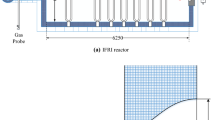Abstract
In this work, the process of combustion of coal particles under turbulent regime in a high-temperature reaction chamber is modeled through 3D discrete element method (DEM) simulations. By assuming the occurrence of interfacial transport phenomena between the gas and solid phases, one investigates the influence of the physicochemical properties of particles on the rates of heterogeneous chemical reactions, as well as the influence of eddies present in the gas phase on the mass transport of reactants toward the coal particles surface. Moreover, by considering a simplistic chemical mechanism for the combustion process, thermochemical and kinetic parameters obtained from the simulations are employed to discuss some phenomenological aspects of the combustion process. In particular, the observed changes in the mass and volume of coal particles during the gasification and combustion steps are discussed by emphasizing the changes in the chemical structure of the coal. In addition to illustrate how DEM simulations can be used in the modeling of consecutive and parallel chemical reactions, this work also shows how heterogeneous and homogeneous chemical reactions become a source of mass and energy for the gas phase.










Similar content being viewed by others
References
Alobaid F, Ströhle J, Epple B (2013) Extended CFD/DEM model for the simulation of circulating fluidized bed. Adv Powder Technol 24:403–415
ANSYS Inc. (2012) Tutorial: multiple char reactions. Canonsburg
ANSYS Inc. (2015) ANSYS Fluent 16.2. Canonsburg
ANSYS Inc. (2015) ANSYS fluent theory guide release 16.2. Canonsburg
Badzioch S, Hawksley PGW (1970) Kinetics of thermal decomposition of pulverized coal particles. Ind Eng Chem Process Des Dev 9:521–530
Boyd RK, Kent JH (1988) Three-dimensional furnace computer modeling. Symp (Int) Combust 21:265–274
Bulíček M, Málek J, Rajagopal KR (2012) On Kelvin–Voigt model and its generalizations. Evol Equ Contr Theor 01:17–42
Cundall PA, Strack OD (1979) A discrete numerical model for granular assemblies. Geotechnique 29:47–65
Deen NG, van Sint Amaland M, van der Hoef MA, Kuipers JAM (2007) Review of discrete particle modeling of fluidized beds. Chem Eng Sci 62:28–44
Fan L, Zhu C (2005) Principles of gas-solid flows. Cambridge Press, Cambridge
Hayes RE, Kolaczkowski ST (1997) Introduction to catalytic combustion. Gordon and Breach Science Publishers, Amsterdam
Hutter K, Jöhnk KJ (2004) Continuum methods of physical modeling: continuum mechanics, dimensional analysis, turbulence. Springer, Berlin
Krugel-Emden H, Simsek E, Rickelt S, Wirtz S, Scherer V (2007) Review and extension of normal force models for the discrete element method. Powder Technol 11:157–173
Kumar KV, Porkadi K, Rocha F (2008) Langmuir–Hinshelwood kinetics—a theoretical study. Catal Commun 9:82–84
Lide DR (ed) (2009) CRC handbook of chemistry and physics, 89th edn. CRC Press, Boca Raton
Magnussen BF (1981) On the structure of turbulence and a generalized eddy dissipation concept for chemical reaction in turbulent flow. American Institute of Aeronautics and Astronautics, Saint Louis
Magnussen BF, Hjertager BH (1977) On mathematical modeling of turbulent combustion with special emphasis on sort formation and combustion. Symp (Int) Combust 16:719–729
Manion JA, Huie RE, Levin RD, B DR Jr, Orkin VL, Tsang W, McGiven WS, Hudgens JW, Knyazev VD, Atkinson DB, Chai E, Tereza AM, Lin C, Allison T, Mallard WG, Westley F, Herron JT, Hampson RF, Frizzell DH (2015) NIST chemical kinetics database 17. National Institute of Standards and Technology, Gaithersburg
O‘Rourke PJ (1981) Collective drop effects on vaporizing liquid sprays. Princeton University Press, Princeton
Readey DW (2016) Kinetics in materials science and engineering. CRC Press, Boca Raton
Reis MC, Wang Y (2017) A two-fluid model for reactive dilute solid-liquid mixtures with phase changes. Continuum Mech Thermodyn 29:509–534
Sommerfeld M, van Wachen B, Oliemans R (2008) Best practice guidelines for computational fluid dynamics of dispersed multi-phase flows. ERCOFTAC, Bedford
Somorjai GA, Li Y (2010) Introduction to surface chemistry and catalysis, 2nd edn. Wiley, Hoboken
Warnatz J, Maas U, Dibble R (2006) Combustion: physical and chemical fundamentals, modeling and simulation, experiments, pollutant formation. Springer, Berlin
Funding
The first author acknowledges Brazilian Coordination for the Improvement of Higher Education Personnel (CAPES) and Alexander von Humboldt Stiftung for the financial support (Process BEX 8227/14-4).
Author information
Authors and Affiliations
Corresponding author
Ethics declarations
Conflict of interest
The authors declare that they have no conflict of interest.
Rights and permissions
About this article
Cite this article
Reis, M.C., Alobaid, F. & Wang, Y. Toward the modeling of combustion reactions through discrete element method (DEM) simulations. Comp. Part. Mech. 5, 579–591 (2018). https://doi.org/10.1007/s40571-018-0191-x
Received:
Accepted:
Published:
Issue Date:
DOI: https://doi.org/10.1007/s40571-018-0191-x




